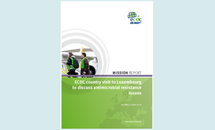ECDC country visit to Luxembourg to discuss antimicrobial resistance issues
Following an official invitation by the Ministry of Health in Luxembourg, an ECDC team conducted visits and meetings to discuss AMR issues in the country with the overall objective of providing an evidence-based assessment of the situation in Luxembourg regarding prevention and control of AMR through prudent use of antibiotics and infection control.
This country visit was conducted as a joint One Health AMR country visit together with a team from the European Commission’s Directorate General for Health and Food Safety, and took place on 29 May - 2 June 2017.
Antibiotic consumption in Luxembourg is at the EU average in hospitals, but higher than the EU average in the community. The AMR levels in bacterial isolates from humans are at or below the EU average.
Executive summary
Rationale and purpose of the country visit
The Council Recommendation of 15 November 2001 on the prudent use of antimicrobial agents in human medicine (2002/77/EC) outlines the threat that antimicrobial resistance (AMR) poses to human health, and advocates for a range of action to be taken for its prevention and control. The Council Conclusions on antimicrobial resistance of 10 June 2008 reiterated this call for action.
To assist Member States in implementing the Council Recommendation, ECDC has developed a process for and is carrying out, upon invitation from national authorities, country visits to specifically discuss and assess the situation of the country regarding prevention and control of AMR through prudent use of antibiotics and infection control. These country visits also help document how Member States have approached this implementation and ongoing national activities to support the European Commission in evaluating this implementation.
The main output of the visit is a report from ECDC provided to the inviting national authority. To help the ECDC to ensure consistency of the visits and follow-up the progress of countries, an assessment tool has been developed. This assessment tool includes ten topics which are regarded as core areas for successful prevention and control of AMR and are based on Council Recommendation 2002/77/EC and on the Council Conclusions of 10 June 2008. The assessment tool is used as a guide for discussions during the visit.
Following an official invitation by the Ministry of Health in Luxembourg, an ECDC team conducted visits and meetings to discuss AMR issues in the country with the overall objective of providing an evidence-based assessment of the situation in Luxembourg regarding prevention and control of AMR through prudent use of antibiotics and infection control. This country visit was conducted as a joint One Health AMR country visit together with a team from the European Commission’s Directorate General for Health and Food Safety.
Conclusions
Antibiotic consumption in Luxembourg is at the EU average in hospitals, but higher than the EU average in the community. There may have been a small decrease in antibiotic prescriptions in the community since 2013 but this trend needs to be confirmed in the coming years. There has also been a 30% decrease in antibiotic prescriptions in children between 2006 and 2015.
The AMR levels in bacterial isolates from humans are at or below the EU average. According to The European Antimicrobial Resistance Surveillance Network (EARS-Net), the percentage of S. aureus bloodstream infections that are meticillin-resistant (i.e. MRSA) decreased slowly between 2012 and 2015. However, looking at the increasing trends of multidrug-resistant Escherichia coli from EARS-Net, there is a concern for more serious AMR problems in the future. Moreover, national experts and professionals are also concerned by the increasing number of cases of extended spectrum beta-lactamase (ESBL)-producing Enterobacteriaceae in hospitals, and, in one hospital that we visited, by the increasing use of last-line antibiotics such as carbapenems, as well as the slow emergence of carbapenemase-producing Enterobacteriaceae (CPE).
There are multiple sources of data on AMR and on antimicrobial consumption at the national and local level in hospitals that are currently not consistently used by national and local experts for further analysis, and to implement and evaluate targeted interventions to prevent and control AMR.
Cross-border issues seem to have a greater importance in Luxembourg than in many other EU Member States. Firstly, patients are transferred across borders from Luxembourg to other countries and back to Luxembourg. These transfers could for example be necessary because certain medical procedures cannot be provided in the country, and this risks importing multidrug-resistant bacteria. Secondly, a large proportion of the population has connections with other countries and travels back and forth between Luxembourg and their country of origin. These persons may have different expectations about the need for antibiotics for common infections. Thirdly, medical doctors and other healthcare professionals usually train in neighbouring countries where they may be taught varied clinical and prescribing practices. While these cross-border aspects represent a challenge for Luxembourg, they could also be considered as an incentive to exchange best practices and foster cross-border collaboration.
Patients are often transferred between long-term care facilities and hospitals. As reported by acute care hospitals, long-term care facilities may represent an uncontrolled reservoir of multidrug-resistant bacteria.
Luxembourg is in a position to reverse the above-mentioned emerging AMR trends. In the past years, Luxembourg has implemented several good actions at the national or local level, often driven by personal initiative and efforts of a few dedicated professionals. This can be seen as the first phase of a process, which now needs official status, national coordination, enhanced collaboration, and support to ensure sustainability and meet future challenges.
Download





